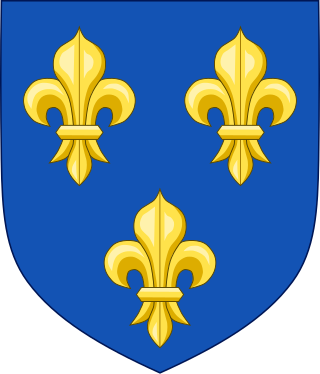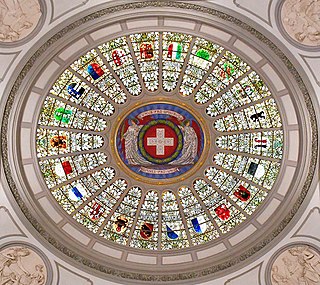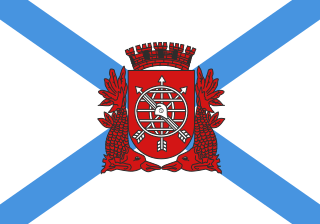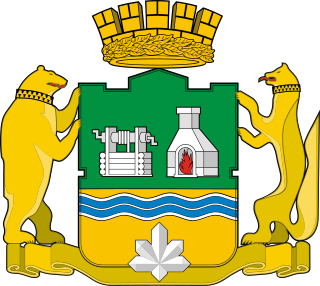The coat of arms of St. Thomas, Ontario, Canada, like all others, has special meaning.
At the top of the coat of arms is Colonel Talbot's hound standing on a crown.
The shield depicts a carpenter's square in the upper right corner, which is the symbol of Saint Thomas the apostle, patron saint of builders. A seven-spoked wheel in the lower left corner symbolizes the seven townships of Elgin County with the city of St. Thomas at the centre. It is also a wheel of progress, symbolic of St. Thomas as a historically significant rail centre and developing industrial centre with emphasis on the automotive and transportation industries.
On a diagonal through the centre of the shield, there are two parallel white lines representing transportation tracks. The lines enclose three maple leaves which symbolize loyalty to the Queen, Canada, and respect for the authority of government at three levels: municipal, provincial and federal.
The background colour of the shield, light green, signifies the growth and vitality of the city.

The fleur-de-lis, also spelled fleur-de-lys, is a common heraldic charge in the shape of a lily. Most notably, the fleur-de-lis is depicted on the traditional coat of arms of France that was used from the High Middle Ages until the French Revolution in 1792, and then again in brief periods in the 19th century. This design still represents France and the House of Bourbon in the form of marshalling in the arms of Spain, Quebec and Canada, for example.

In heraldry, the field (background) of a shield can be divided into more than one area, or subdivision, of different tinctures, usually following the lines of one of the ordinaries and carrying its name. Shields may be divided this way for differencing or for purposes of marshalling, or simply for style. The lines that divide a shield may not always be straight, and there is a system of terminology for describing patterned lines, which is also shared with the heraldic ordinaries.

The coat of arms of Ontario is the armorial emblem representing the Canadian province of Ontario. The arms contain symbols reflecting Ontario's British heritage, along with local symbols. At the upper part of the shield is the red cross of St. George, representing England. The lower portion of the shield features three golden maple leaves on a green background.

Each of the 26 modern cantons of Switzerland has an official flag and a coat of arms. The history of development of these designs spans the 13th to the 20th centuries.

In heraldry, an ordinary is one of the two main types of charges, beside the mobile charges. An ordinary is a simple geometrical figure, bounded by straight lines and running from side to side or top to bottom of the shield. There are also some geometric charges known as subordinaries, which have been given lesser status by some heraldic writers, though most have been in use as long as the traditional ordinaries. Diminutives of ordinaries and some subordinaries are charges of the same shape, though thinner. Most of the ordinaries are theoretically said to occupy one-third of the shield; but this is rarely observed in practice, except when the ordinary is the only charge.

Wainfleet is a rural township in southern Niagara Region, Ontario, Canada.

Canting arms are heraldic bearings that represent the bearer's name in a visual pun or rebus.

The first coat of arms of Montreal was designed by Jacques Viger, the first mayor of Montreal, and adopted in 1833 by the city councillors. Modifications were made some one hundred five years later and adopted on 21 March 1938, and again on 13 September 2017, resulting in the version currently in use. The coat of arms was the only city emblem representing Montreal until 1981, when a stylized logo was developed for common daily use, reserving the coat of arms for ceremonial occasions.

The anchored cross, or mariner's cross, is a stylized cross in the shape of an anchor. It is a symbol which is shaped like a plus sign depicted with anchor-like fluke protrusions at its base. There are many variations on this symbol, but the most common form connects a ring with a bar, with a cross-bar, terminating on the other end with two curved branches or arrowheads. The anchor symbolizes hope, steadfastness, calm and composure. It also can symbolize security in one or more uncertain experiences of life, such as sea voyages, one's fate after death, and the vagaries of fortune.
Abkhazia is a region in the Caucasus that is under the effective control of the partially recognised self-declared Republic of Abkhazia. The de jure majority internationally recognized Autonomous Republic of Abkhazia claims to be its legitimate government.

The coat of arms of Edmonton is the heraldic symbol used to represent the city. The coat of arms was granted to Edmonton on 28 October 1994.

The national emblem of East Timor is one of the national symbols of East Timor.

The coat of arms of Windsor, Ontario, is a coat of arms that symbolizes the city's past, present, and its culture. The two lions represent royalty and allegiance to The Crown; the deer represents the richness in wildlife in the area. The automobile wheel represents the city's automobile industry. Roses represent the city's warm climate and numerous parks, as well as its nickname "City of Roses". The shield shows the fleur-de-lis, for its French Canadian population, with the Detroit River along the bottom. The ribbon along the bottom is the city's motto: "The River and the Land Sustain Us".

The coat of arms of Kropyvnytskyi is one of the city's symbols reflecting its past and the controversies of its history.

A pall in heraldry and vexillology is a Y-shaped charge, normally having its arms in the three corners of the shield. An example of a pall placed horizontally (fesswise) is the green portion of the South African national flag.

The coat of arms of Saint Kitts and Nevis was adopted in 1983 and possesses the motto "Country Above Self". The previous coat of arms, adopted in 1967 by the colony of Saint Christopher-Nevis-Anguilla, was nearly identical, except for coloration and the motto "Unity in Trinity".

The flag of the City of Rio de Janeiro or flag of São Sebastião do Rio de Janeiro consists of a white rectangle with a blue saltire behind the coat of arms of the city of Rio de Janeiro, which is displayed red in the center. Its basic design has changed little since it was adopted on July 8, 1908, except during period from 1960 to 1975 when the municipality of Rio de Janeiro was known as Guanabara State. It resembles the flags of Galicia and the Russian Navy.

The coat of arms of Aarhus is an official symbol of Aarhus based on one of the oldest surviving seals of the medieval Danish market towns. The coat of arms can be traced back to a seal used in Aarhus around 1250. The oldest known preserved seal was in a document from 24 June 1356 which was lost in destruction during the Second World War. The seal has had a number of different forms during its 750 year long existence.

The flag of Knoxville, Tennessee, was officially adopted by municipal ordinance on October 16, 1896. It is the third oldest official city flag in the United States and the oldest flag of any state or city governmental entity in Tennessee.

The coat of arms of Yekaterinburg is the official municipal coat of arms of Yekaterinburg, Russia. The current symbol was adopted on 23 May 2008 and consists of a French shield divided horizontally into two fields, with a white mine shaft and a white furnace within the top field, which is green, and a blue wavy bend within the bottom field, which is gold. A gold bear and gold sable are located to the left and right of the shield, respectively. A gold crown with a gold laurel wreath is located above the shield and a gold ribbon is located below the shield. A grey druse is located at the bottom center of the shield.